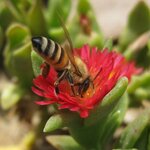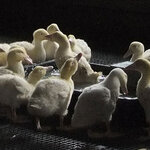Ecology & Zoology

Natural pollen makes honey bees significantly more resistant to pesticides than an artificial diet and pesticide exposure causes changes in gene expression related to diet and nutrition, according to a new study.
Diet even impacts how long bees can survive when given lethal doses of a pesticide.
To make their determination, the scientists first fed one of two miticides -- coumaphos or fluvalinate, the two most abundant and frequently detected pesticides in the hive -- to bees for a period of seven days. On the seventh day, the researchers extracted RNA from the bees, attached a…

More than 60 years after the last confirmed sighting, a strange deer with vampire-like fangs is roaming the rugged forested slopes of northeast Afghanistan, according to a research team which confirmed the species presence during recent surveys.
Known as the Kashmir musk deer, the last scientific sighting in Afghanistan was made by a Danish survey team traversing the region in 1948. The species is categorized as Endangered on the IUCN Red List due to habitat loss and poaching. Its scent glands are coveted by wildlife traffickers and are considered more valuable by weight than gold, fetching…

If you see a bat zooming toward you this evening, cover your hair. But if you do get bit, you will probably not the flu.
Halloween bats can be a little scary knowing they are not going to spread most viruses. A research project finds that influenza viruses carried by bats pose a low risk to humans.
"Bats are natural reservoirs of some of the most deadly zoonotic viruses, including rabies virus, Ebola virus, Henipaviruses and SARS coronavirus," said Wenjun Ma, one of the lead investigators and an assistant professor of virology at Kansas State University. "Recently, sequences…

Courtesy of Guiomar Liste
By: Nala Rogers, Inside Science
(Inside Science) -- When ducklings head out to bathe in a pool, they usually follow the same individual, new research has found. But do they visit the pool that’s best for everyone, or just the one their chief prefers? This puzzle has made it hard for farmers to know how to provide for all their ducks equally, and for biologists to know what social animals really want.
Originally, the researchers wanted to know whether ducks prefer deep pools where they can swim, or shallow pools where they can put their feet down. They divided…

Talk to long-time anglers with a favorite spot and they will often tell stories of one fish they could never get. In mythical overtones, they will speak of its ability to avoid capture, attributing an almost supernatural intelligence (for a fish). Such stories were once so common that 'fish story' became its own brand of tall tale.
A new study mapped individual heritable traits of fish to environmental conditions and concluded that some fish really are going to be harder to catch.
The work by the University of Eastern Finland and the Finnish Game and Fisheries Research Institute
in the…

Ferns are an old plant species, dinosaurs munched on them over 200 million years ago. If we want to know how to survive against nature's onslaught over the long haul, ferns are as good a place as any to start.
Even recent ones can show us how to evolve and outlast. A group of ferns evolved much more recently, and they did it while colonizing the extreme environment of the high Andes. Their completely new morphology (form and structure) arose and diversified within the last 2 million years. How this group of ferns grew in a unique ecosystem of the Andean mountains was the subject of a new…

Alpine goats appear to be shrinking in size, according to scholars at Durham University, and that is due to global warming over the past 30 years, they say.
Young Chamois now weigh about 25 percent less than animals of the same age in the 1980s, they found, and note that in recent years, decreases in body size have been identified in a variety of animal species and have frequently been linked by other scholars to changing climate.
Yet they believe the decline in size of Chamois is unprecedented in its speed and magnitude, they write in Frontiers in Zoology. There is just one…

By Peter Gwynne, Inside Science
(Inside Science) – Each day small sea creatures known as plankton rise from deep underwater to the ocean's surface during the night and then return to the depths in daytime. Zoologists describe this “diel” movement, named after the Latin word for day, as Earth’s biggest migration.
The stimulus for this mass migration has long puzzled scientists. But a team from the European Molecular Biology Laboratory in Heidelberg, Germany has now discovered a likely answer: melatonin, the hormone that influences humans' sleep patterns so significantly that it's sometimes…

Modern day kangaroos exhibit a hopping form of locomotion. Credit: Leo/Flickr, CC BY-SA
By Christine Janis, Brown University
Extinct giant kangaroos may have been built more for walking, rather than hopping like today’s kangaroos, especially when moving slowly.
These sthenurine kangaroos existed until around 30,000 years ago, diverging from a common (hopping) ancestor with the kangaroo/ wallaby group around 13 million years ago, and leaving no descendants. Our research, published today in PLOS ONE, demonstrates that they may have employed a kind of locomotion not seen in living kangaroos:…

Human bathroom walls contain messages that are wonderfully informative about our modern condition - they can tell you who to call if you have an evolutionary mandate to procreate or even notify you that someone else once peed in the same spot.
White-footed sportive lemurs learn a lot about each other due to bathrooms also. Only instead of writing on the walls, they use scent-marks to communicate with their own kind. A study published online in Behavioral Ecology and Sociobiology by Iris Dröscher and Peter Kappeler from the German Primate Center (DPZ) found that the urine left on latrine trees…